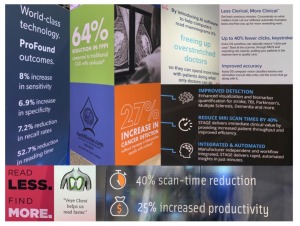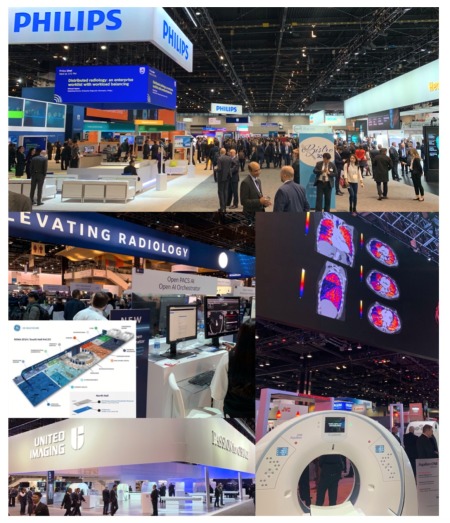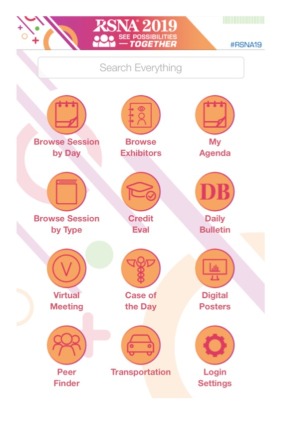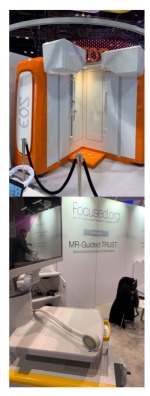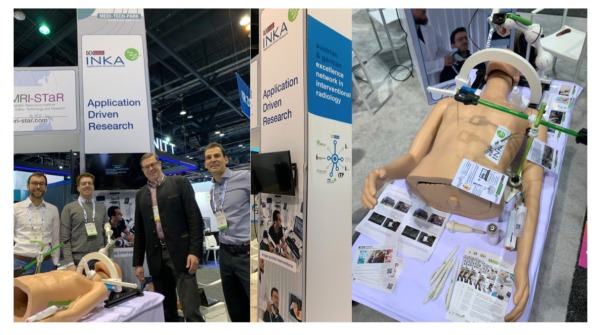Michael Friebe’s 28th private, slightly biased, and as always subjective report
December 03, 2019
An editorial by Michael Friebe
2016 report title: BEYOND IMAGING: Radiology is Changing! Big Data / Machine and Deep Learning / Artificial Intelligence is everywhere!
2017:—Machine Learning in the center of Radiology Innovation
And 2018 :—AI / MACHINE LEARNING IS MAINSTREAM NOW — RSNA(I) 2018 IN AN EXPONENTIAL WORLD. There will never be an RSNA without AI and there will only very few products in the future that will not take advantage of the AI capabilities.
The official 2019 Logo is “SEE POSSBILITIES TOGETHER” - I really like it and therefore use it as well ... this is a great “Massive Transformative Purpose” and highlights the need of cooperation and interdisciplinary work, something that is also extremely important in my personal work and environment, since Innovation develops best at the intersection of many disciplines with the patient in mind and in anticipation of future healthcare delivery changes.
I know that many of you are waiting for the really important information concerning my activity level, the weather and the food that I consumed. Well, here we go ... pretty boring actually ... heavy on the meat ... and with the exception of the weather not much different from last years.
Sunday evening is - at least for the last 10 years - the infamous GMMM at the Harray Carey restaurant. With about 10 regulars and 5-10 newly invited. Want to know about this fun and secret event 😉 ? Contact me next year around September when I make the reservation again - no guarantees though!
Going quickly back to AI. This year there was even a complete hall (underneath hall B ... did not even know that this existed) dedicated to AI Innovation and companies. Look at the "value propositions“ for AI programs and applications that I collected to see the sales arguments.
Weather: already listed in the table above ...
Attendance: not sure ... I believe less, but then there was the additional AI hall and separate 3D printing and Start-Up corner sections with an increased poster area. Chaos and traffic congestion in front of McCormick place trying to board a Taxi, Uber or Lyft was extreme during the busy hours ... so maybe I am wrong with the lower attendance.
Politics: Some improvements were observed to the extreme partisan discussions of last year. But still shocking to realize what one person can destroy with respect to grown relations, morals, foreign understanding and global trade. My personal report obviously contains personal notes and that is one ...
Booth Setup, Design and General Impressions:
CANON and GE in Hall A, separated by the very bright UNITED IMAGING (UI). Siemens Healthineers and PHILIPS directly adjacent to each other in Hall B and at least for me with identical size floorspace.
BOOTH CONTEST:
Which brings us to the MF booth contest (only the 4 main OEM‘s compete — but maybe I have to add UI the next time, even though they would not have made it in the top three this year due to their relatively boring and bright setup).
For all novel readers I am not judging content at all, only and merely how they look and “feel”.
Some comments: the CANON display was fantastic, other than that a little too cosy for me; a negative for PHILIPS was the reception hidden inside the booth and a little confusing setup; HEALTHINEERS was too packed, too full, and the obvious separation with the two floors felt “excluding” (I know that they have that for several years already, but that does not make it better); GE warm (wooden panels, cozy sitting areas) and well organized with a single floor setup.
So for the first time ever I award the annual FIRST PRICE IN THE RSNA MF BOOTH CONTEST to GENERAL ELECTRIC, followed by CANON and a joined third for SIEMENS HEALTHINEERS and PHILIPS.
Congratulations!
What was NEW at the major OEM?
You first need to understand my search and asking process. I typically make an appointment with people from the OEM that I know well and they then organize a personalized tour. Some glitches with PHILIPS this year, but in general worked well.
I then ask the presenting staff for things that they themselves think are the key innovations. And with key innovations I mean the combination of REDUCING COST and DIAGNOSTIC/THERAPY ERRORS, and an OUTCOME and PATIENT EXPERIENCE IMPROVEMENT ... and obviously something that nobody else has.
They all tried hard and told my team (this year I brought two of my PhD students and my Chair Manager with me) the highlights that they believed fit this criteria. If you consider improvement of low percentage numbers and cost reductions in the same order as outstanding, than they all had something to show and present.
This is called INCREMENTAL INNOVATION! What I was really looking for is DISRUPTION, something that changes these attributes by a factor of 10 or even more. Well, I did not find anything that qualified to achieve or potentially achieve that in the next 3-5 years. This is completely understandable when you know the business models, but I also believe that they need to engage in more EXPERIMENTATION challenging their own business models to achieve real — and needed — disruption in the near future.
Interesting also, that several manufacturer claimed to be the only ones that can do certain things (particularly with respect to AI implementation for noise reduction, data crunching, data integration from different sources, ...) and we then realized that all of them use similar approaches, call it something slightly different, and are surprised to hear that others are doing their unique „thing“ as well.
So, nothing that really impressed me and that caught my undivided attention and admiration, but at least several „honorable mention“ — and here I include UNITED IMAGING that surpassed all others with certain numbers: 75cm 3T MRI bore diameter and 50cm x 60cm imaging FOV, 640 slice CT (don‘t know why you would need that and what application would really benefit from that — there were at least two more Chinese manufacturer with 512 slice CT).
Honorable Mention (all: AI integration for patient workflow, reconstruction, noise reduction, scan speed increase, parameter optimization, prospective patient evaluation, ...):
CANON: MRI noise reduction and blanket coils. 320 slice PRISM Spectral CT (80 keV and 135 keV), 32 MHz US probe for extreme high resolution imaging.
GE: CT positioning camera without the need for an additional SCOUT view, EDISON software platform for all modalities that can also be opened to external organizations, contrast enhanced spectral mammography system with integrated novel biopsy device, and the AIR coils for MRI (even a „diaper“ coil).
HEALTHINEERS: the CORINDUS catheter robot integration and a renewed interest in therapy, complete set of cable free Ultrasound probes, new X.Cite CT platform.
PHILIPS: VR capabilities show for the cath/angiolab systems, sleek new PET/CT, Phase Contrast CT.
Thanks a lot to all that helped organize these tours (see picture below).
RSNA Innovation:
It is now possible to attend — the scientific presentations — as Virtual Meeting Participant (maybe also a reason for the lower number of visitors), and the RSNA developed a rather useful smartphone app.
Internet connectivity was excellent ... I had several video conferences without any technical issues sharing the bandwidth with several thousands.
UBER / LYFT is really successful and many attendees pick these means of transportation rather than bus or train. This causes massive traffic jams and delays at the boarding areas and was also a reason that many left before official closing hours to avoid getting stuck — take the METRA ... best public transportation to downtown in my opinion.
Technological Innovations — smaller companies:
Lots of AI companies!
Business models still a little unclear to me, but if they provide clear workflow (e.g. SMART REPORTING) advantages or make imaging easier, better and more powerful (e.g. KOIOS, CONTEXTFLOW, IBM) then they will find the way to the customers purse.
Many other interesting concept ideas — even without AI — EOS showed a standing X-ray with two simultaneous image acquisitions and a very intuitive way to determine exposure area. The images that I saw were quite nice. Killer application: do not know.
Our friends from FRAUNHOFER showed a MR guided transcranial ultrasound stimulation device that is able to temporarily break the blood brain barrier to allow medication to enter. Interesting idea with quite some technological challenges apparently solved now.
HITACHI showed an oval bore MRI ... maybe the easier way to create more space considering the gravitational forces that the human body is exposed to 😉 .
BEST highlighted a small compact system to produce PET nuclides. A very special system for special needs, but as a former operator of PET/CT systems I was quite impressed. And then there was HYPERFINE! I started my diagnostic imaging career as R&D engineer for one of the very early MRI innovators — DIASONICS in South San Francisco (later bought by TOSHIBA now CANON) and heavily involved in the development of a 640G (64mT or 40x less magnetic field strength than a 3 T magnet) open MRI system. This system was subsequently sold 500 times!
And now we have HYPERFINE, a point of care MRI with 640G!! I do not remember why we picked 640G at the time, but I am totally excited about the resurrection of such an ultra-low field MRI. Image quality is decent and the system runs for quite a bit less than €100.000 — I happen to know a couple of other companies that are working on alternative concepts using low field magnets. And it could also be the basis for an interventional MRI concept ... a topic that I work on since 1993!
And then I saw this beautiful full ring detector CT from NANOVISION, which reminded me of one of the first CT systems that I worked with, a PICKER PQ that also had a full ring detector. That was also a very cool system at the time.
Are some older technologies and technology approaches coming back? Why not, if it makes sense for dedicated applications!
Outlook
This year my university chair — and companies that we have worked with for years — again had our own booth (3752 in Hall A) under the header GERMAN AUSTRIAN EXCELLENCE NETWORK IN INTERVENTIONAL RADIOLOGY. A honorable mention also to another company and research chair from our university with a joint booth (NEOSCAN/Stimulate) highlighting a neonatal MRI system development.
We were very happy with the attendance and interest in our patented prototype designs — we had high calibre visitors from all the mentioned OEM‘s and many others.
We hope that we can continue and expand the established relationships as we will reorganize our research setup at the university.
After 5 rather successful years as Professor of Image Guided Therapies I will drastically reduce my engagement at the university with the beginning of 2020, but still be responsible for our INNOLAB IMAGE GUIDED THERAPIES at the medical faculty and with that for UNMET CLINICAL NEED INNOVATION. You will see me in 2020 in a new and challenging role at the intersection of future oriented MEDTEC INNOVATION GENERATION and COMMERCIALIZATION. But no decision made yet where and what!
Look forward meeting and interacting with you next year! An exciting 12 month to everyone! Connect via LinkedIN + TWITTER
2016 report title: BEYOND IMAGING: Radiology is Changing! Big Data / Machine and Deep Learning / Artificial Intelligence is everywhere!
2017:—Machine Learning in the center of Radiology Innovation
And 2018 :—AI / MACHINE LEARNING IS MAINSTREAM NOW — RSNA(I) 2018 IN AN EXPONENTIAL WORLD. There will never be an RSNA without AI and there will only very few products in the future that will not take advantage of the AI capabilities.
The official 2019 Logo is “SEE POSSBILITIES TOGETHER” - I really like it and therefore use it as well ... this is a great “Massive Transformative Purpose” and highlights the need of cooperation and interdisciplinary work, something that is also extremely important in my personal work and environment, since Innovation develops best at the intersection of many disciplines with the patient in mind and in anticipation of future healthcare delivery changes.
I know that many of you are waiting for the really important information concerning my activity level, the weather and the food that I consumed. Well, here we go ... pretty boring actually ... heavy on the meat ... and with the exception of the weather not much different from last years.
Sunday evening is - at least for the last 10 years - the infamous GMMM at the Harray Carey restaurant. With about 10 regulars and 5-10 newly invited. Want to know about this fun and secret event 😉 ? Contact me next year around September when I make the reservation again - no guarantees though!
Going quickly back to AI. This year there was even a complete hall (underneath hall B ... did not even know that this existed) dedicated to AI Innovation and companies. Look at the "value propositions“ for AI programs and applications that I collected to see the sales arguments.
Weather: already listed in the table above ...
Attendance: not sure ... I believe less, but then there was the additional AI hall and separate 3D printing and Start-Up corner sections with an increased poster area. Chaos and traffic congestion in front of McCormick place trying to board a Taxi, Uber or Lyft was extreme during the busy hours ... so maybe I am wrong with the lower attendance.
Politics: Some improvements were observed to the extreme partisan discussions of last year. But still shocking to realize what one person can destroy with respect to grown relations, morals, foreign understanding and global trade. My personal report obviously contains personal notes and that is one ...
Booth Setup, Design and General Impressions:
CANON and GE in Hall A, separated by the very bright UNITED IMAGING (UI). Siemens Healthineers and PHILIPS directly adjacent to each other in Hall B and at least for me with identical size floorspace.
BOOTH CONTEST:
Which brings us to the MF booth contest (only the 4 main OEM‘s compete — but maybe I have to add UI the next time, even though they would not have made it in the top three this year due to their relatively boring and bright setup).
For all novel readers I am not judging content at all, only and merely how they look and “feel”.
Some comments: the CANON display was fantastic, other than that a little too cosy for me; a negative for PHILIPS was the reception hidden inside the booth and a little confusing setup; HEALTHINEERS was too packed, too full, and the obvious separation with the two floors felt “excluding” (I know that they have that for several years already, but that does not make it better); GE warm (wooden panels, cozy sitting areas) and well organized with a single floor setup.
So for the first time ever I award the annual FIRST PRICE IN THE RSNA MF BOOTH CONTEST to GENERAL ELECTRIC, followed by CANON and a joined third for SIEMENS HEALTHINEERS and PHILIPS.
Congratulations!
What was NEW at the major OEM?
You first need to understand my search and asking process. I typically make an appointment with people from the OEM that I know well and they then organize a personalized tour. Some glitches with PHILIPS this year, but in general worked well.
I then ask the presenting staff for things that they themselves think are the key innovations. And with key innovations I mean the combination of REDUCING COST and DIAGNOSTIC/THERAPY ERRORS, and an OUTCOME and PATIENT EXPERIENCE IMPROVEMENT ... and obviously something that nobody else has.
They all tried hard and told my team (this year I brought two of my PhD students and my Chair Manager with me) the highlights that they believed fit this criteria. If you consider improvement of low percentage numbers and cost reductions in the same order as outstanding, than they all had something to show and present.
This is called INCREMENTAL INNOVATION! What I was really looking for is DISRUPTION, something that changes these attributes by a factor of 10 or even more. Well, I did not find anything that qualified to achieve or potentially achieve that in the next 3-5 years. This is completely understandable when you know the business models, but I also believe that they need to engage in more EXPERIMENTATION challenging their own business models to achieve real — and needed — disruption in the near future.
Interesting also, that several manufacturer claimed to be the only ones that can do certain things (particularly with respect to AI implementation for noise reduction, data crunching, data integration from different sources, ...) and we then realized that all of them use similar approaches, call it something slightly different, and are surprised to hear that others are doing their unique „thing“ as well.
So, nothing that really impressed me and that caught my undivided attention and admiration, but at least several „honorable mention“ — and here I include UNITED IMAGING that surpassed all others with certain numbers: 75cm 3T MRI bore diameter and 50cm x 60cm imaging FOV, 640 slice CT (don‘t know why you would need that and what application would really benefit from that — there were at least two more Chinese manufacturer with 512 slice CT).
Honorable Mention (all: AI integration for patient workflow, reconstruction, noise reduction, scan speed increase, parameter optimization, prospective patient evaluation, ...):
CANON: MRI noise reduction and blanket coils. 320 slice PRISM Spectral CT (80 keV and 135 keV), 32 MHz US probe for extreme high resolution imaging.
GE: CT positioning camera without the need for an additional SCOUT view, EDISON software platform for all modalities that can also be opened to external organizations, contrast enhanced spectral mammography system with integrated novel biopsy device, and the AIR coils for MRI (even a „diaper“ coil).
HEALTHINEERS: the CORINDUS catheter robot integration and a renewed interest in therapy, complete set of cable free Ultrasound probes, new X.Cite CT platform.
PHILIPS: VR capabilities show for the cath/angiolab systems, sleek new PET/CT, Phase Contrast CT.
Thanks a lot to all that helped organize these tours (see picture below).
RSNA Innovation:
It is now possible to attend — the scientific presentations — as Virtual Meeting Participant (maybe also a reason for the lower number of visitors), and the RSNA developed a rather useful smartphone app.
Internet connectivity was excellent ... I had several video conferences without any technical issues sharing the bandwidth with several thousands.
UBER / LYFT is really successful and many attendees pick these means of transportation rather than bus or train. This causes massive traffic jams and delays at the boarding areas and was also a reason that many left before official closing hours to avoid getting stuck — take the METRA ... best public transportation to downtown in my opinion.
Technological Innovations — smaller companies:
Lots of AI companies!
Business models still a little unclear to me, but if they provide clear workflow (e.g. SMART REPORTING) advantages or make imaging easier, better and more powerful (e.g. KOIOS, CONTEXTFLOW, IBM) then they will find the way to the customers purse.
Many other interesting concept ideas — even without AI — EOS showed a standing X-ray with two simultaneous image acquisitions and a very intuitive way to determine exposure area. The images that I saw were quite nice. Killer application: do not know.
Our friends from FRAUNHOFER showed a MR guided transcranial ultrasound stimulation device that is able to temporarily break the blood brain barrier to allow medication to enter. Interesting idea with quite some technological challenges apparently solved now.
HITACHI showed an oval bore MRI ... maybe the easier way to create more space considering the gravitational forces that the human body is exposed to 😉 .
BEST highlighted a small compact system to produce PET nuclides. A very special system for special needs, but as a former operator of PET/CT systems I was quite impressed. And then there was HYPERFINE! I started my diagnostic imaging career as R&D engineer for one of the very early MRI innovators — DIASONICS in South San Francisco (later bought by TOSHIBA now CANON) and heavily involved in the development of a 640G (64mT or 40x less magnetic field strength than a 3 T magnet) open MRI system. This system was subsequently sold 500 times!
And now we have HYPERFINE, a point of care MRI with 640G!! I do not remember why we picked 640G at the time, but I am totally excited about the resurrection of such an ultra-low field MRI. Image quality is decent and the system runs for quite a bit less than €100.000 — I happen to know a couple of other companies that are working on alternative concepts using low field magnets. And it could also be the basis for an interventional MRI concept ... a topic that I work on since 1993!
And then I saw this beautiful full ring detector CT from NANOVISION, which reminded me of one of the first CT systems that I worked with, a PICKER PQ that also had a full ring detector. That was also a very cool system at the time.
Are some older technologies and technology approaches coming back? Why not, if it makes sense for dedicated applications!
Outlook
This year my university chair — and companies that we have worked with for years — again had our own booth (3752 in Hall A) under the header GERMAN AUSTRIAN EXCELLENCE NETWORK IN INTERVENTIONAL RADIOLOGY. A honorable mention also to another company and research chair from our university with a joint booth (NEOSCAN/Stimulate) highlighting a neonatal MRI system development.
We were very happy with the attendance and interest in our patented prototype designs — we had high calibre visitors from all the mentioned OEM‘s and many others.
We hope that we can continue and expand the established relationships as we will reorganize our research setup at the university.
After 5 rather successful years as Professor of Image Guided Therapies I will drastically reduce my engagement at the university with the beginning of 2020, but still be responsible for our INNOLAB IMAGE GUIDED THERAPIES at the medical faculty and with that for UNMET CLINICAL NEED INNOVATION. You will see me in 2020 in a new and challenging role at the intersection of future oriented MEDTEC INNOVATION GENERATION and COMMERCIALIZATION. But no decision made yet where and what!
Look forward meeting and interacting with you next year! An exciting 12 month to everyone! Connect via LinkedIN + TWITTER


